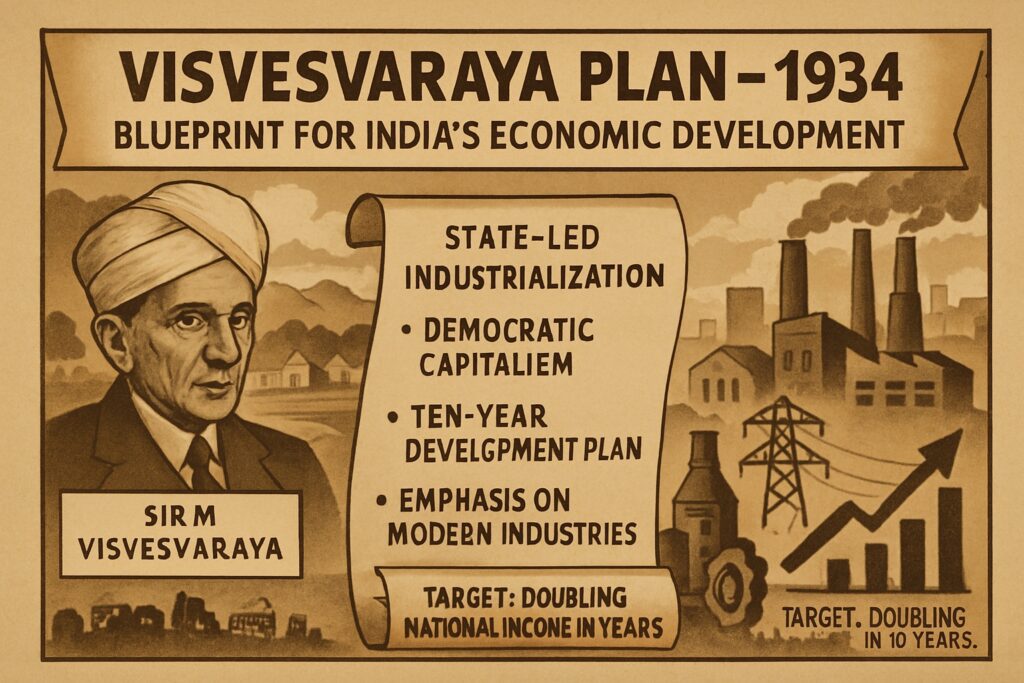The history of planning in India reflects the country’s journey toward economic development and self-reliance. After gaining independence in 1947, India adopted a planned economic model to overcome poverty, underdevelopment, and inequality. The idea was to use systematic and goal-oriented planning to utilize the nation’s resources efficiently. This led to the formation of a central planning body and the introduction of Five-Year Plans, inspired by the Soviet model.
Table of Contents
Pre-Independence Planning Efforts
Even before independence, there were several initiatives that laid the foundation for future planning:
Visvesvaraya Plan
The Visvesvaraya Plan, proposed in 1934 by Sir M. Visvesvaraya, was one of the earliest attempts to outline a comprehensive economic development strategy for India. It was titled “A Planned Economy for India” and emphasized industrialization and scientific planning to achieve rapid economic progress.
Features of the Visvesvaraya Plan:
- Advocated industrialization as the main strategy to shift from an agrarian to an industrial economy.
- Supported democratic capitalism with minimal government control and a role for both public and private sectors.
- Aimed to make India self-reliant within a ten-year time frame through infrastructure and manufacturing.
- Proposed limited state intervention in key sectors like infrastructure, education, and skill development.
- Emphasized technical and engineering education to build a skilled industrial workforce.

National Planning Committee
The National Planning Committee (NPC) was established in 1938 under the leadership of Jawaharlal Nehru, marking the first major effort by Indian leaders to outline a systematic plan for national economic development.
Features of the National Planning Committee:
- Aimed to develop a comprehensive plan for India’s economic and social development.
- Emphasized state ownership of key industries and public services.
- Advocated rapid industrialization to generate employment and boost the economy.
- Proposed agricultural reforms to increase productivity and ensure food security.
- Focused on equitable wealth distribution and social welfare.
- Encouraged scientific and data-based economic planning.
- Laid the foundation for post-independence Five-Year Plans and the Planning Commission.
It recommended state control over the economy and stressed scientific and industrial development.
Bombay Plan (1944)
Prepared by a group of leading industrialists like J.R.D. Tata and G.D. Birla, it supported state intervention in heavy industries and infrastructure.
- People’s Plan (1945):
Drafted by M.N. Roy, this plan advocated for agricultural and industrial nationalization and was more socialist in approach.
Post-Independence Planning:
After independence, India chose to follow a mixed economy model with an active role for the public sector. In 1950, the Planning Commission was set up under the chairmanship of Jawaharlal Nehru, the first Prime Minister of India.
Five-Year Plans (1951–2017):
India launched a series of Five-Year Plans aimed at economic development. Each plan focused on specific sectors such as agriculture, industry, education, health, and infrastructure.
1. First Five-Year Plan (1951–1956):
- Focus: Agriculture, irrigation, and power
- Based on the Harrod-Domar model
- Success due to good monsoons and increased food production
2. Second Plan (1956–1961):
- Focus: Industrialization
- Based on the Mahalanobis model
- Emphasis on heavy industries and public sector
3. Third Plan (1961–1966):
- Focus: Self-reliant growth
- Interrupted by wars with China (1962) and Pakistan (1965)
- Food shortage and economic crisis
Plan Holiday (1966–1969):
- No Five-Year Plan due to economic instability
- Annual plans were implemented
4th to 12th Five-Year Plans (1969–2017):
- Varied focus areas such as poverty reduction, employment generation, modernization, inclusive growth, and sustainability
- Liberalization began during the 8th Plan (1992–1997) after the 1991 economic reforms
End of Five-Year Plans:
- The 12th Five-Year Plan (2012–2017) was the last.
- In 2015, the Planning Commission was replaced by the NITI Aayog (National Institution for Transforming India), focusing on a more decentralized and flexible planning approach.
Objectives of Economic Planning in India:
- Economic growth and development
- Reduction of poverty and inequality
- Employment generation
- Self-sufficiency in food production
- Industrial and technological development
- Balanced regional development
Conclusion:
The history of planning in India reflects the nation’s consistent effort to shape its economy and improve the quality of life for its citizens. From centralized Five-Year Plans to the more adaptive and cooperative approach of NITI Aayog, India’s planning strategy has evolved to meet changing economic challenges and global trends. While the Five-Year Plans are now part of history, their legacy continues to influence India’s development journey.